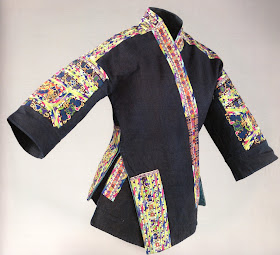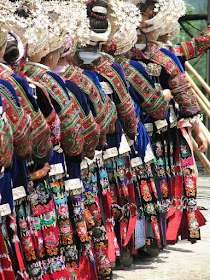Hello all,
Today i will talk about a particular applique technique used by some of the Hmu people. The Hmu are one branch of the Hmongic peoples, which the Han Chinese call Miao. This is found in the township of Kaili and county of Taijiang, Qiandongnan Miao and Dong Autonomous Prefecture, which lies in the southeast of the Chinese Province of Guizhou. The villages which are famous for this technique are Weng Xiang, Geyi, Kaitang, Shidong, Langde and Xijiang.
Here is a map of Qiangdongnan so that you may orient yourself.
My sources call this technique Duixiu, but I suspect that this is a Chinese term and not an indigenous one.
This technique consists of cutting cloth into squares or rectangles, then folding them into triangles and appliqueing the triangles onto decorative panels which are used in various ways.
This is not unknown in the west. In America, these are called 'prairie points', and are often used to decorate the edges of quilts.
https://www.thespruce.com/making-prarie-points-for-quilts-2821842
In Transylvanian Hungarian costumes, they often edge the neckline and armholes of the bodice.
In Hmu work, however, they are made from silk and the work is much finer, individual squares being about 1 cm rather than a few inches.
Preparation of the silk.
This and many of the how-to images below are from 'One Needle, One Thread' by Tomoko Torimaru. Click to enlarge.
In Xijiang and Langde, numbers 64 and 62 on the map above, respectively, we find the simplest use of this technique, which resembles that used in the west. As for many Miao, the women's costume consists of a jacket and a pleated skirt. Here is a jacket from Xijiang.
Embroidered panels are sewn to the jacket. Here is a closeup of one such panel.
The silk triangles are placed on top of a strip of gold paper as part of the edging around the embroidery.
In Langde, the technique is slightly more complex.Here are a couple of images of the Langde costume.
You can see that there are various panels used on the jacket.
Here is a closeup of one of the panels.
Here the triangles are layered.
Shidong is number 42 on the map above. They use a couple of different versions of this technique.
Here is the costume of Shidong.
The panel on the back of the collar and the ones on the rear of the shoulders are done in this technique.
Here is a jacket from Shidong.
Here is a closeup of one collar panel.
In Shidong they will sometimes use embroidery for the center of the design, as here. The rest of the design is built up by layering the silk triangles.
The shoulder panels are made using a different technique.
In Geyi, # 71, Kaitang, # 70, and especially Wengxiang # 32 on the map above, they use a remarkably complex version of this technique.
Some of the panels form geometric shapes. Here is an outfit from Geyi.
Here is a detail of the ornament. Each of these squares is formed of overlapping appliqued triangles, together with some strips and rectangles.
Here is a jacket from Geyi.
This jacket is from the Kaitang area.
This detail is shown larger than actual size.
Here are more details of this technique.
Wengxiang uses this same technique, but is known for other compositions, not just geometric.
Birds and fish are common motifs.
Especial care and attention is lavished on accessories for babies. Here is a baby carrier done in this technique.
and a closeup.
Complex and elaborate baby hats are very common all over China among many ethnic groups. They are covered with protective talismans. Here are a couple from Wengxiang.
Here follow complete instructions on how to make this hat, with many details of technique.
Silver ornaments along with tassels, pompoms or artificial flowers complete the hat.
Thank you for reading, I hope that you have found this to be interesting and informative.
Perhaps some of you might be inspired to try out a project using this technique, or adapt some of these ideas to a quilt.
Roman K.
email: rkozakand@aol.com
Source Material:
Martha Longenecker et al, 'Silver and Silk - Textiles and Jewelry of Guizhou, China', Tokyo, 2002
Robert Lam Ping-fai et al., 'Ethnic Costumes of the Miao People in China', Hong Kong, 1986
Florian Knothe et al., 'Embroidered Identities - Ornately Decorated Textiles and Accessories of Chinese Ethnic Minorities', Hong Kong, 2013
Zeng, Xianyang, 'Ethnic Miao Embroidery - The Zeng Collection', 2009
Tomoko Torimaru, 'One Needle, One Thread - Miao (Hmong) Embroidery and Piecework from Guizhou, China', Hong Kong, 2008
Catherine Bourzat et al., 'Tribal Textiles from Southwest China', Bangkok, 2016
























































